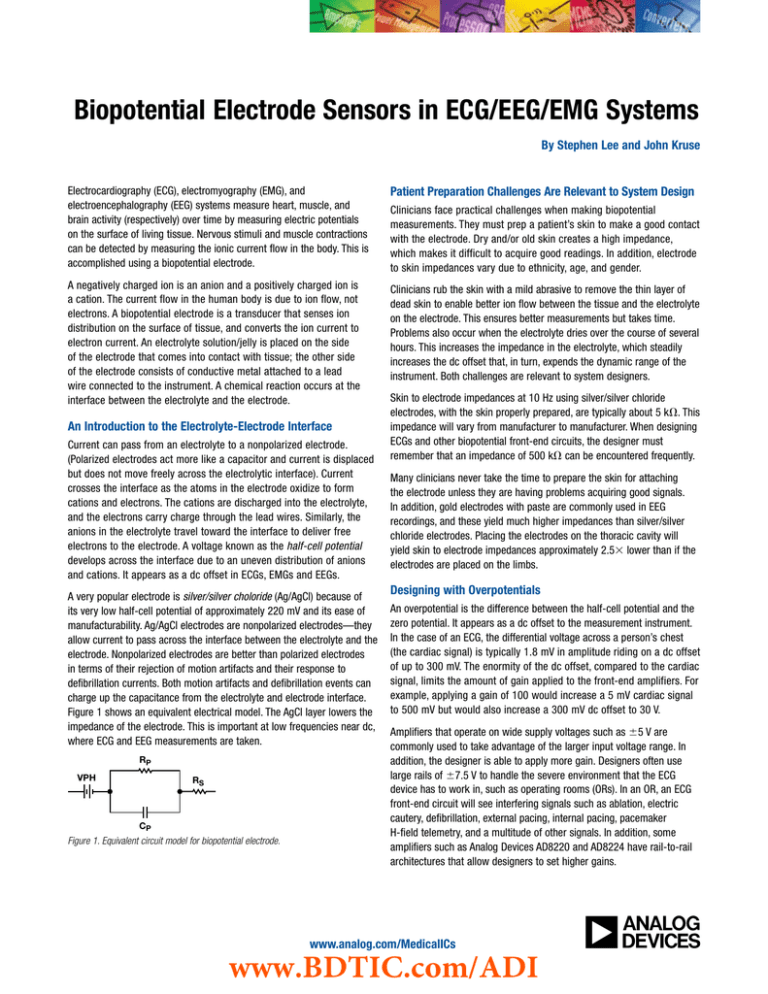
Biopotential Electrode Sensors in ECG/EEG/EMG Systems
By Stephen Lee and John Kruse
Electrocardiography (ECG), electromyography (EMG), and
electroencephalography (EEG) systems measure heart, muscle, and
brain activity (respectively) over time by measuring electric potentials
on the surface of living tissue. Nervous stimuli and muscle contractions
can be detected by measuring the ionic current flow in the body. This is
accomplished using a biopotential electrode.
Patient Preparation Challenges Are Relevant to System Design
A negatively charged ion is an anion and a positively charged ion is
a cation. The current flow in the human body is due to ion flow, not
electrons. A biopotential electrode is a transducer that senses ion
distribution on the surface of tissue, and converts the ion current to
electron current. An electrolyte solution/jelly is placed on the side
of the electrode that comes into contact with tissue; the other side
of the electrode consists of conductive metal attached to a lead
wire connected to the instrument. A chemical reaction occurs at the
interface between the electrolyte and the electrode.
Clinicians rub the skin with a mild abrasive to remove the thin layer of
dead skin to enable better ion flow between the tissue and the electrolyte
on the electrode. This ensures better measurements but takes time.
Problems also occur when the electrolyte dries over the course of several
hours. This increases the impedance in the electrolyte, which steadily
increases the dc offset that, in turn, expends the dynamic range of the
instrument. Both challenges are relevant to system designers.
An Introduction to the Electrolyte-Electrode Interface
Current can pass from an electrolyte to a nonpolarized electrode.
(Polarized electrodes act more like a capacitor and current is displaced
but does not move freely across the electrolytic interface). Current
crosses the interface as the atoms in the electrode oxidize to form
cations and electrons. The cations are discharged into the electrolyte,
and the electrons carry charge through the lead wires. Similarly, the
anions in the electrolyte travel toward the interface to deliver free
electrons to the electrode. A voltage known as the half-cell potential
develops across the interface due to an uneven distribution of anions
and cations. It appears as a dc offset in ECGs, EMGs and EEGs.
A very popular electrode is silver/silver choloride (Ag/AgCl) because of
its very low half-cell potential of approximately 220 mV and its ease of
manufacturability. Ag/AgCl electrodes are nonpolarized electrodes—they
allow current to pass across the interface between the electrolyte and the
electrode. Nonpolarized electrodes are better than polarized electrodes
in terms of their rejection of motion artifacts and their response to
defibrillation currents. Both motion artifacts and defibrillation events can
charge up the capacitance from the electrolyte and electrode interface.
Figure 1 shows an equivalent electrical model. The AgCl layer lowers the
impedance of the electrode. This is important at low frequencies near dc,
where ECG and EEG measurements are taken.
RP
VPH
RS
CP
Figure 1. Equivalent circuit model for biopotential electrode.
Clinicians face practical challenges when making biopotential
measurements. They must prep a patient’s skin to make a good contact
with the electrode. Dry and/or old skin creates a high impedance,
which makes it difficult to acquire good readings. In addition, electrode
to skin impedances vary due to ethnicity, age, and gender.
Skin to electrode impedances at 10 Hz using silver/silver chloride
electrodes, with the skin properly prepared, are typically about 5 kΩ. This
impedance will vary from manufacturer to manufacturer. When designing
ECGs and other biopotential front-end circuits, the designer must
remember that an impedance of 500 kΩ can be encountered frequently.
Many clinicians never take the time to prepare the skin for attaching
the electrode unless they are having problems acquiring good signals.
In addition, gold electrodes with paste are commonly used in EEG
recordings, and these yield much higher impedances than silver/silver
chloride electrodes. Placing the electrodes on the thoracic cavity will
yield skin to electrode impedances approximately 2.5× lower than if the
electrodes are placed on the limbs.
Designing with Overpotentials
An overpotential is the difference between the half-cell potential and the
zero potential. It appears as a dc offset to the measurement instrument.
In the case of an ECG, the differential voltage across a person’s chest
(the cardiac signal) is typically 1.8 mV in amplitude riding on a dc offset
of up to 300 mV. The enormity of the dc offset, compared to the cardiac
signal, limits the amount of gain applied to the front-end amplifiers. For
example, applying a gain of 100 would increase a 5 mV cardiac signal
to 500 mV but would also increase a 300 mV dc offset to 30 V.
Amplifiers that operate on wide supply voltages such as ±5 V are
commonly used to take advantage of the larger input voltage range. In
addition, the designer is able to apply more gain. Designers often use
large rails of ±7.5 V to handle the severe environment that the ECG
device has to work in, such as operating rooms (ORs). In an OR, an ECG
front-end circuit will see interfering signals such as ablation, electric
cautery, defibrillation, external pacing, internal pacing, pacemaker
H-field telemetry, and a multitude of other signals. In addition, some
amplifiers such as Analog Devices AD8220 and AD8224 have rail-to-rail
architectures that allow designers to set higher gains.
www.analog.com/MedicalICs
www.BDTIC.com/ADI
Electrode Amplifiers
Another common problem is polarizing the electrode. The input
bias current of the front-end amplifiers can polarize the electrode if
there is poor skin contact. Figure 2 shows JFET input op amps such
as Analog Devices AD8625/AD8626/AD8627 and AD8641/AD8642/
AD8643 that have input bias currents of less than 1 pA. JFET input
instrumentation amplifiers such as the AD8220 and AD8224, shown in
Figure 2 and Figure 3, have input bias currents under 20 pA.
+5V
+5V
AD8627
–5V
–5V
+5V
+5V
+5V
AD8220
AD8627
–5V
–5V
–5V
Figure 2. The AD8627 JFET operational amplifier used as a buffer for low input
bias current.
+5V
–5V
+5V
–5V
+5V
AD8224
–5V
Figure 3. The AD8224 JFET instrumentation amplifier offers low input bias current.
Conclusion
Understanding the electrochemical interaction in electrodes helps clarify
their behavioral nuances. In addition, it enables designers to understand
the challenges clinicians face when placing electrodes on patients. A
thorough understanding of the electrode to skin interface ensures that
the signal acquisition is correct and reliable, enabling the clinician to
correctly diagnose the patient’s condition.
References
Webster, John G. (1998). Medical Instrumentation: Application and Design.
New Jersey: John Wiley & Sons, Inc.
Schmitt, OH and JJ. Almasi. (1970). “Electrode impedance and
voltage offset as they affect efficiency and accuracy of VCG and ECG
measurement.” Proceedings of the XI International Vectocardiography
Symposium. New York: North Holland Publishing Co.
©2008 Analog Devices, Inc. All rights reserved.
Trademarks and registered trademarks are the property
of their respective owners.
T07465-0-4/08
www.analog.com/MedicalICs
www.BDTIC.com/ADI
Analog Devices, Inc.
Worldwide Headquarters
Analog Devices, Inc.
One Technology Way
P.O. Box 9106
Norwood, MA 02062-9106
U.S.A.
Tel: 781.329.4700
(800.262.5643,
U.S.A. only)
Fax: 781.461.3113
Analog Devices, Inc.
Europe Headquarters
Analog Devices, Inc.
Wilhelm-Wagenfeld-Str. 6
80807 Munich
Germany
Tel: 49.89.76903.0
Fax: 49.89.76903.157
Analog Devices, Inc.
Japan Headquarters
Analog Devices, KK
New Pier Takeshiba
South Tower Building
1-16-1 Kaigan, Minato-ku,
Tokyo, 105-6891
Japan
Tel: 813.5402.8200
Fax: 813.5402.1064
Analog Devices, Inc.
Southeast Asia
Headquarters
Analog Devices
22/F One Corporate Avenue
222 Hu Bin Road
Shanghai, 200021
China
Tel: 86.21.2320.8000
Fax: 86.21.2320.8222




